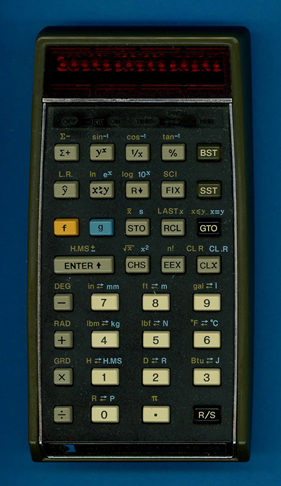
DATAMATH CALCULATOR MUSEUM
 |
DATAMATH CALCULATOR MUSEUM |
Hewlett-Packard HP-55
| Date of introduction: | January 1, 1975 | Display technology: | LED |
| New price: | $395 (MSRP June 1975) | Display size: | 10 + 2 |
| Size: | 5.8" x 3.1" x
1.3" 148 x 80 x 33 mm3 |
||
| Weight: | 9.0 ounces, 255 grams | Serial No: | 1704S01804 |
| Batteries: | HP-82001A (3*NiCd AA-size) | Date of manufacture: | wk 04 year 1977 |
| AC-Adapter: | HP-82002 | Origin of manufacture: | Singapore |
| Precision: | 10 | Integrated circuits: | |
| Logic: | RPN | ||
| Memories: | 20 | ||
| Program steps: | 49 | Courtesy of: | Ken H. Meine |

![]()

 Hewlett-Packard
introduced this HP-55 in January 1975, three years after the revolutionary
HP-35 known as the World's first pocket sized electronic calculator
performing both logarithmic and trigonometric functions. The HP-55 was slotted
in HP's calculator portfolio between the HP-45 Advanced
Scientific calculator and the HP-65 Programmable
calculator. It marks the last calculator in Hewlett-Packard's series of "First
Generation Handheld Calculators".
Hewlett-Packard
introduced this HP-55 in January 1975, three years after the revolutionary
HP-35 known as the World's first pocket sized electronic calculator
performing both logarithmic and trigonometric functions. The HP-55 was slotted
in HP's calculator portfolio between the HP-45 Advanced
Scientific calculator and the HP-65 Programmable
calculator. It marks the last calculator in Hewlett-Packard's series of "First
Generation Handheld Calculators".
The
feature set of the HP-55 includes a 100-hour digital time with a resolution of
1/100th of a second and an accuracy of better than 0.01%. Results are
stored in the 10 memory registers, allowing to clock 10 different events or
"splits". The HP-55 adds an impressive 38 functions to the already very capable
HP-45 and 49 steps of programming.
Milestones of HP calculators
Hewlett-Packard (HP) introduced in 1968 the World's first desktop scientific calculator, the HP 9100A. The programmable calculator stores programs on magnetic cards and lets scientists perform complex calculations without the need to access much larger computers. It is 10 times faster than most machines at solving science and engineering problems. Advertisements for the 9100A call the device a "personal computer," one of the first documented uses of the term.
Only 4 years later, on January 4, 1972, HP makes another advance in personal computing with the HP-35, the World's first scientific handheld calculator. Small enough to fit into a shirt pocket, the powerful HP-35 makes the engineer's slide rule obsolete. With the HP-80 a similar business model was introduced in February 1, 1973. In May of 1973 the HP-45 followed before the first programmable model HP-65 was introduced in January 19, 1974 with a retail price of $795. The HP-70 was introduced in August 1974 to complement the HP-80 as lower end business calculator and it took another few months till the introduction of the HP-55 in January 1975, the last calculator in Hewlett-Packard's series of "First Generation Handheld Calculators". Early in the year 1975 the price tag of the HP-35 dropped to $195 and the calculator was discontinued soon after with the introduction of its successor HP-21, a member of the "Second Generation Handheld Calculators". The introduction of the HP-31E in May 1978 together with its siblings HP-33E and HP-38E marked with the "Third Generation of Handheld Calculators" the end of HP calculators with LED Displays before introducing the revolutionary HP-41C with its alphanumeric LC-Display in July 1979 and the everlasting HP-12C and its sibling HP-11C in September 1981.
In the year 1975 dozens of companies manufactured calculators with 4 functions
and a selling price below $20, scientific and business calculators in the
range around $100 and programmable calculators priced about $250. The slide rule
was outdated and famous companies like Dennert & Pape (ARISTO), A.W.
Faber-Castell and Keuffel & Esser stopped the production.
If you have additions to the above article please email: joerg@datamath.org.
© Joerg Woerner, December 12, 2023. No reprints without written permission.